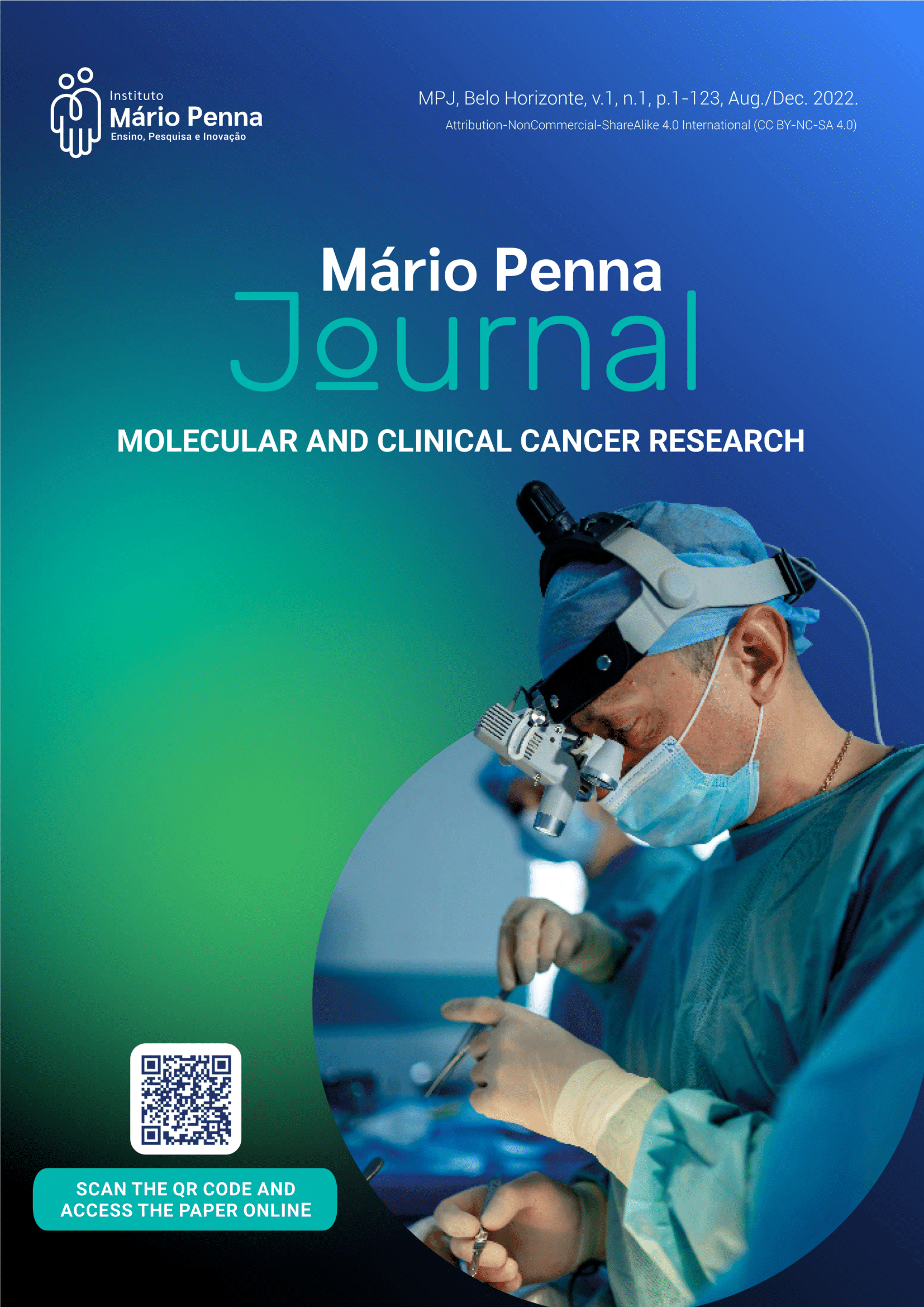PREVENTION AND TREATMENT OF SKIN INJURIES CAUSED BY DRUG INFILTRATION AND EXTRAVASSION
INTEGRATIVE REVIEW
DOI:
https://doi.org/10.61229/mpj.v1i1.6Keywords:
Nursing Care, Extravasation of Therapeutic and Diagnostic Materials, Peripheral Catheterization, Infusions and Extravasations and NecrosisAbstract
intravenously can occur in several clinical contexts and is predominantly associated with peripheral venous catheters. The objective was to identify scientific evidence in the literature on the prevention and treatment of skin lesions, caused by infiltration and leakage of chemotherapeutic drugs, seeking methods that guide the practices practiced by nursing in order to improve the care provided to patients undergoing venipuncture. Method: Integrative review study carried out on the VHL portal, in the PubMed, Lillacs, Medline and BDENF databases. The following inclusion criteria were used: articles published without limit of dates, in Portuguese, English and Spanish. The sample consisted of eight studies developed in different countries. Intervention in the face of overflow requires updated theoretical and practical foundation, since safety in the administration process of chemotherapeutic agents is part of the nursing routine, being its responsibility. In this sense, it is essential to monitor the quality of care, reflect on clinical practice based on what is observed and reinforce the patient safety culture. As final considerations, although there are no uniform recommendations on the best strategy to adopt in order to prevent infiltration and leakage of drugs, adequate diagnosis and treatment may prevent long-term sequelae
Downloads
References
COFEN.Conselho Federal de Enfermagem. Resolução nº 210 de 01 de julho de 1998. Dispõe sobre a atuação dos profissionais de enfermagem que trabalham com quimioterápicos antineoplásicos dentro das normas de biossegurança estabelecidas pelo Ministério da Saúde conforme Portaria n. 170/SAS. São Paulo:COFEN. Documentos Básicos de Enfermagem.; 2001.
Schulmeister L. Extravasation management: clinical update. Semin Oncol Nurs. 2011;27(1):82-90. doi: 10.1016/j.soncn.2010.11.010. DOI: https://doi.org/10.1016/j.soncn.2010.11.010
Pérez Fidalgo JA, García Fabregat L, Cervantes A, Margulies A, Vidall C, Roila F; ESMO Guidelines Working Group. Management of chemotherapy extravasation: ESMO--EONS clinical practice guidelines. Eur J Oncol Nurs. 2012;16(5):528-34. doi: 10.1016/j.ejon.2012.09.004. DOI: https://doi.org/10.1016/j.ejon.2012.09.004
Batista OMA, Moreira RF, Sousa AFL, Moura MEB, Andrade D, Madeira MZA. Fatores de risco para as complicações locais da terapia intravenosa periférica. Rev. Enferm. UFPI. [Internet] 2014;3(3):88-93. [acesso em 6 abr 2020]. Disponível:http://www.ojs.ufpi.br/index.php/reufpi/article/view/1540. DOI: https://doi.org/10.26694/reufpi.v3i3.1540
Souza NR, Bushatsky M, Figueiredo EG, Melo JTS, Freire DA, Santos ICRV. Emergência oncológica: atuação dos enfermeiros no extravasamento de drogas quimioterápicas antineoplásicas.Esc. Anna Nery Rev. Enferm.2017; 21(1): e20170009.
Al-Benna S, O'Boyle C, Holley J. Extravasation injuries in adults. ISRN Dermatol. 2013; 2013:856541. doi: 10.1155/2013/856541. DOI: https://doi.org/10.1155/2013/856541
Payne, A. S. Extravasation injury from chemotherapy and other non-antineoplastic Vesicants. UptoDate; 2014. https://me-menu.com.ua/public/pdf/1857.pdf?c=0
Schneider F, Pedrolo, E. Extravasamento de drogas antineoplásicas: avaliação do conhecimento da equipe de enfermagem. REME rev. min. enferm.2011;15(4):522-529.
Hannon MG, Lee SK. Extravasation injuries. J Hand Surg Am. 2011;36(12):2060-5. doi: 10.1016/j.jhsa.2011.10.001. DOI: https://doi.org/10.1016/j.jhsa.2011.10.001
Reynolds PM, MacLaren R, Mueller SW, Fish DN, Kiser TH. Management of extravasation injuries: a focused evaluation of noncytotoxic medications. Pharmacotherapy. 2014;34(6):617-32. doi: 10.1002/phar.1396 DOI: https://doi.org/10.1002/phar.1396
Susser WS, Whitaker-Worth DL, Grant-Kels JM. Mucocutaneous reactions to chemotherapy. J Am Acad Dermatol. 1999;40(3):367-98. doi: 10.1016/s0190-9622(99)70488-3. DOI: https://doi.org/10.1016/S0190-9622(99)70488-3
Caliri, MHL, Marziale, MHP.A prática de enfermagem baseada em evidências: conceitos e informações disponíveis online. Revista Latino-Americana de Enfermagem [online]. 2000, 8(4):103-104. [Acessado 28 out 2022]. Disponível em: <https://doi.org/10.1590/S0104-11692000000400015>. DOI: https://doi.org/10.1590/S0104-11692000000400015
Galvão, CM.Níveis de evidência. Acta Paulista de Enfermagem [online]. 2006[Acessado 28 Out 2022];19(2):5. Disponível em: <https://doi.org/10.1590/S0103-21002006000200001>. DOI: https://doi.org/10.1590/S0103-21002006000200001
Stetler CB, Brunell M, Giuliano KK, Morsi D, Prince L, Newell-Stokes V. Evidence-based practice and the role of nursing leadership. J Nurs Adm. 1998;28(7-8):45-53. doi: 10.1097/00005110-199807000-00011. DOI: https://doi.org/10.1097/00005110-199807000-00011
Santos, CMC, Pimenta, CAM, Nobre, MRC.The PICO strategy for the research question construction and evidence search. Revista Latino-Americana de Enfermagem [online]. 2007 [Acessado 28 Out 2022];(3):508-511.Disponível em: <https://doi.org/10.1590/S0104-11692007000300023>. DOI: https://doi.org/10.1590/S0104-11692007000300023
Soares CB, Hoga, LAK, Peduzzi M, Sangaleti C, Yonekura T, DRAD. Integrative Review: Concepts And Methods Used In Nursing. Revista da Escola de Enfermagem da USP [online]. 2014; [Acessado 28 Out 2022] 48(02):335-345. Disponível em: <https://doi.org/10.1590/S0080-6234201400002000020>. DOI: https://doi.org/10.1590/S0080-6234201400002000020
Melo JMA, Oliveira PP, Souza RS, Fonseca DF, Gontijo TF, Rodrigues AB. Prevention and conduct against the Extravasation of antineoplastic chemotherapy: a scoping review.Rev. bras. Enferm.2020; 73(4): e20190008. http://dx.doi.org/10.1590/0034-7167-2019-0008. DOI: https://doi.org/10.1590/0034-7167-2019-0008
Wengström Y, Margulies A; European Oncology Nursing Society Task Force. European Oncology Nursing Society extravasation guidelines. Eur J Oncol Nurs. 2008;12(4):357-61. doi: 10.1016/j.ejon.2008.07.003 DOI: https://doi.org/10.1016/j.ejon.2008.07.003
Schulmeister L. Preventing and managing vesicant chemotherapy extravasations. J Support Oncol. 2010;8(5) 212-215. doi:10.1016/j.suponc.2010.09.002. DOI: https://doi.org/10.1016/j.suponc.2010.09.002
Thigpen JL. Peripheral intravenous extravasation: nursing procedure for initial treatment. Neonatal Netw. 2007;26(6):379-84. doi: 10.1891/0730-0832.26.6.379. DOI: https://doi.org/10.1891/0730-0832.26.6.379
Dougherty L. IV therapy: recognizing the differences between infiltration and extravasation. Br J Nurs. 2008;17(14):896, 898-901. doi: 10.12968/bjon.2008.17.14.30656. DOI: https://doi.org/10.12968/bjon.2008.17.14.30656
Nandiolo-Anelone KR, Allah KC, Cissé L, Bankolé SR, Oulaï M, Aké AY. Les accidents d'extravasation perfusionnelle chez le nouveau-né : une expérience de 15 cas [Extravasation injuries in newborns: our experience about 15 cases]. Chir Main. 2014;33(1):44-50. doi:10.1016/j.main.2013.11.007. DOI: https://doi.org/10.1016/j.main.2013.11.007
Downloads
Published
How to Cite
Issue
Section
License
Copyright (c) 2023 Mário Penna Journal

This work is licensed under a Creative Commons Attribution-NonCommercial-ShareAlike 4.0 International License.
Autores que publicam nesta revista concordam com os seguintes termos:
- Declaro que o presente artigo é original, não tendo sido submetido à publicação em qualquer outro periódico nacional ou internacional, quer seja em parte ou em sua totalidade.
- Declaro, ainda, que uma vez publicado na revista Mário Penna Journal, editada pelo Instituto Mário Penna, o mesmo jamais será submetido por mim ou por qualquer um dos demais co-autores, caso haja, a qualquer outro periódico.
- Por meio deste instrumento, em meu nome e em nome dos demais co-autores, porventura existentes, cedo os direitos autorais do referido artigo ao Instituto Mário Penna e declaro estar ciente de que a não observância deste compromisso submeterá o infrator a sanções e penas previstas na Lei de Proteção de Direitos Autorias (Nº9609, de 19/02/98).

A Revista Mário Penna Journal é licenciada sob uma licença Creative Commons Atribuição-NãoComercial-CompartilhaIgual 4.0 Internacional



